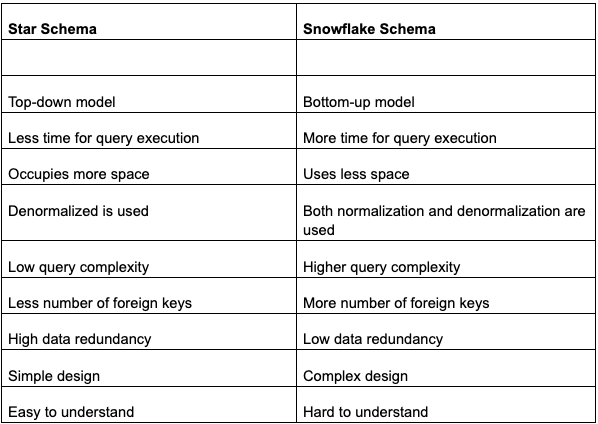As organizations continue to dish out reams of data, a system needs to be in place to collect it all and later use it for analytics. The type of data storage a company chooses to utilize is critical to how effectively they can take advantage of the data they collect.
There are two common methods: star schema and snowflake. Star schema is the simplest method. It involves a fact table at the center connecting to dimension tables around it, looking like a star. Snowflake is a method of storing data in which fact tables, dimension tables and sub-dimension tables are connected through foreign keys. It’s more complex but contains more depth for analysis.
Star Schema vs. Snowflake Schema Defined
- Star Schema: Star schema is the simplest method for arranging data in a data warehouse. It contains a fact table at the center connected to dimension tables around it. Star schema is most effective for quick and simple data query execution.
- Snowflake Schema: Snowflake schema is a more complex method of storing data in which fact tables, dimension tables and sub-dimension tables are connected through foreign keys. Snowflake is most effective for in-depth data query analyses.
Data architects need to factor in parameters like speed, cost, security, dependability, and more when considering the schema they will be using for the storage.
This article throws light on star and snowflake schema, exploring their characteristics and key differences. It also lays down which one works best in a given scenario.
What Is Star Schema?
Star schema is the simplest method for arranging data in a data warehouse. It consists of the fact table at the center connecting to the dimension tables around. The fact table stores information about metrics, while the dimension tables hold information about descriptive attributes.
The schema distinguishes between the fact data related to an organization and the descriptive data attached to it. Star schema contains denormalized data, which refers to the process of adding redundant data to a relational database to improve read performance at the cost of write performance.
Examples of the fact table could be employee names, sales price, sales quantity, and distance measures. Dimension tables associated with such tables will include names of particular employees (John, Bob, etc.), and numerical figures for the other parameters in the fact table.
What Is Snowflake Schema?
Snowflake schema consists of three types of tables: Fact tables, dimension tables and sub-dimension tables.
The fact table is the central table in the schema. The dimension table stores details about the facts. Dimension tables of the snowflake schema are further normalized into sub-dimension tables.
For example, suppose a school has built a database for enrollment of its students and grades. The data architect might make “Enrollment” the central fact table. Dimension tables connected to the fact table might be the “Students” table, containing data on the students, the “Courses” table storing data regarding the courses on the anvil, and the 'Teachers' table with the data about the teachers.
The “Students” dimension table might have sub-dimension tables like “Parental education,” “Family background,” and “Career objectives.” The “Courses” dimension might have sub-dimension tables such as “Language,” “Science,” and “Commerce.” The “Teachers” table might have sub-dimension tables like “Doctorate,” “Sports,” or “Physical education.”
The three tables are inter-connected through foreign keys. A foreign key is a column, or columns, in a table whose values need to essentially match values of a column in the related table. For instance, suppose there’s a restaurant database with an orders table and a customers table. If the algorithm creates a column orders.customer_id referencing the customers.id primary key, any value updated or inserted in orders.customer_id must precisely match a value in customers.id.
An objective of snowflake schema is to normalize the star schema’s denormalized data. Normalization refers to the process of organizing data. Until full normalization occurs, the dimension tables are segregated across multiple sub-tables.
Ultimately, snowflake schema is an extension of a star schema. The dimensions are highly structured, intricate and have multiple connections with each other, thus giving its name, snowflake.
Advantages of Star Schema
Star schema suits applications requiring simplicity and performance. Its main benefits include:
- Simple in structure; has less tables and joins.
- Simple to build and understand.
- Faster data access, since multiple tables don’t have to be joined.
- Doesn’t require complex table joins for querying data.
- Easier to extract data insights.
Disadvantages of Star Schema
Star schema is unsuitable for data warehouses that have complex and dynamic dimensions or that require accuracy and high data normalization. The main disadvantages of the star schema include:
- Uses data denormalization and data redundancy.
- Doesn’t support many-to-many data relationships.
- Can use more storage space due to wide tables.
- Risks data inconsistency.
- Limits complex data queries and data depth/breadth, as data dimension hierarchies flatten into one table.
Advantages of Snowflake Schema
Snowflake schema can accommodate complex and dynamic dimensions and hierarchies. Its main benefits include:
- Efficient and streamlined query handling.
- Supports many-to-many data relationships.
- Uses less storage space (due to data normalization).
- Prevents data repetition and protects data integrity.
- Enables complex data queries, insights and analytics (e.g. drill down analysis).
Disadvantages of Snowflake Schema
Snowflake schema’s main downside is its design complexity and performance. Its disadvantages include:
- Complex structure; can have multiple tables and joins.
- Difficult to build and understand.
- Slower data access and queries.
- Complicated querying due to having many dimension tables.
- Harder to extract data insights.
Key Differences Between Star Schema and Snowflake Schema
Here are the major differences between star schema and snowflake schema:
Star Schema
- Top-down model.
- Less time for query execution.
- Uses more space. Since star schema uses redundant data it can take up a lot of storage space.
- Denormalized data is used.
- Low query complexity.
- Fewer foreign keys.
- High data redundancy.
- Simple design.
- Easy to understand.
Snowflake Schema
- Bottom-up model.
- More time for query execution.
- Uses less space.
- Both normalization and denormalization are used.
- Higher query complexity.
- More foreign keys.
- Low data redundancy.
- Complex design.
- Hard to understand.

Star Schema vs. Snowflake Schema: Which One Is Best for You?
Selecting the right schema depends on the needs of your organization If you need a simple cloud data warehouse solution that offers quick query execution, a star schema might work best. For applications having a few dimensions with limited levels of hierarchy and low cardinality, star schema is suitable. For example, the star schema will be suitable for the sales data warehouse of a small enterprise. Sales might be the central table while time, product, time and employees constitute the dimension tables.
However, if you’re looking for flexibility of use cases while retaining data integrity, a snowflake schema will better serve your needs. Data integrity refers to accuracy, consistency, completeness and validity of an organization's data. For example, a snowflake schema would be effective for a large organization that has a huge amount of normalized data, such as situations when data has been segregated into a string of columns.
Your choice of schema will hinge on factors such as data characteristics, storage constraints, query needs and performance expectations. If you have a few dimensions with limited levels of hierarchy and low cardinality, but you require fast query execution, a star schema is the right choice. However, if you have several dimensions with multiple levels of hierarchy and high cardinality, a snowflake schema will be a better scheme.
Frequently Asked Questions
Why use a snowflake schema instead of a star schema?
Snowflake schema is a suitable fit users want to consume data in a drill down fashion. Its structure makes it easier to dig into data over a duration and compare it to a different data state. For such a requirement, snowflake enables easy-to-understand date dimensions.
Decades -> Years -> QTR -> Month -> Week -> Day -> Time
In other enterprises, organizational cubes might be needed.
Global Org -> Regional Org -> Division -> Local
For any application requiring product data with plenty of drill down options, snowflake will fit in.
Moreover, snowflakes help in preventing repetition. Snowflake is considered a good practice for a data warehouse in a relational database management system (RDBMS) For an online analytical processing (OLAP) database, denormalized data is deemed better.
What are the key differences between star and snowflake schema?
Star schema suits applications that require simplicity and performance, as it has fewer tables and joins. Snowflake schema provides flexibility and normalization, which can accommodate complex and dynamic dimensions and hierarchies.
Star schema utilizes denormalization and redundancy, which improves read performance but can lead to wide dimension tables that take up more storage.
Snowflake schema provides a bottom-up approach that utilizes normalized data. This makes it easier for users to drill down for data and compare data points. But it can also lead to more complex data warehouse design and maintenance.
Is a star schema normalized or denormalized?
Star schema data models are denormalized. This means that data from multiple database tables can be combined into one table, and data redundancy is introduced in the database. Denormalization is used as a technique to optimize database querying and is applied to an already normalized database.
Is star schema obsolete?
Star schema is still a commonly used schema across modern data modeling, database and data warehouse applications.
Is snowflake schema normalized or denormalized?
Snowflake schema data models are normalized. Data normalization organizes data into a structured and normal form, and it works to reduce redundant data in a database.
When not to use a star schema?
It’s best not to use a star schema for data warehouses that are complex, have dynamic dimensions or require high accuracy and data normalization. A star schema denormalizes data, which can limit data depth and breadth and affect performance in the above cases.





